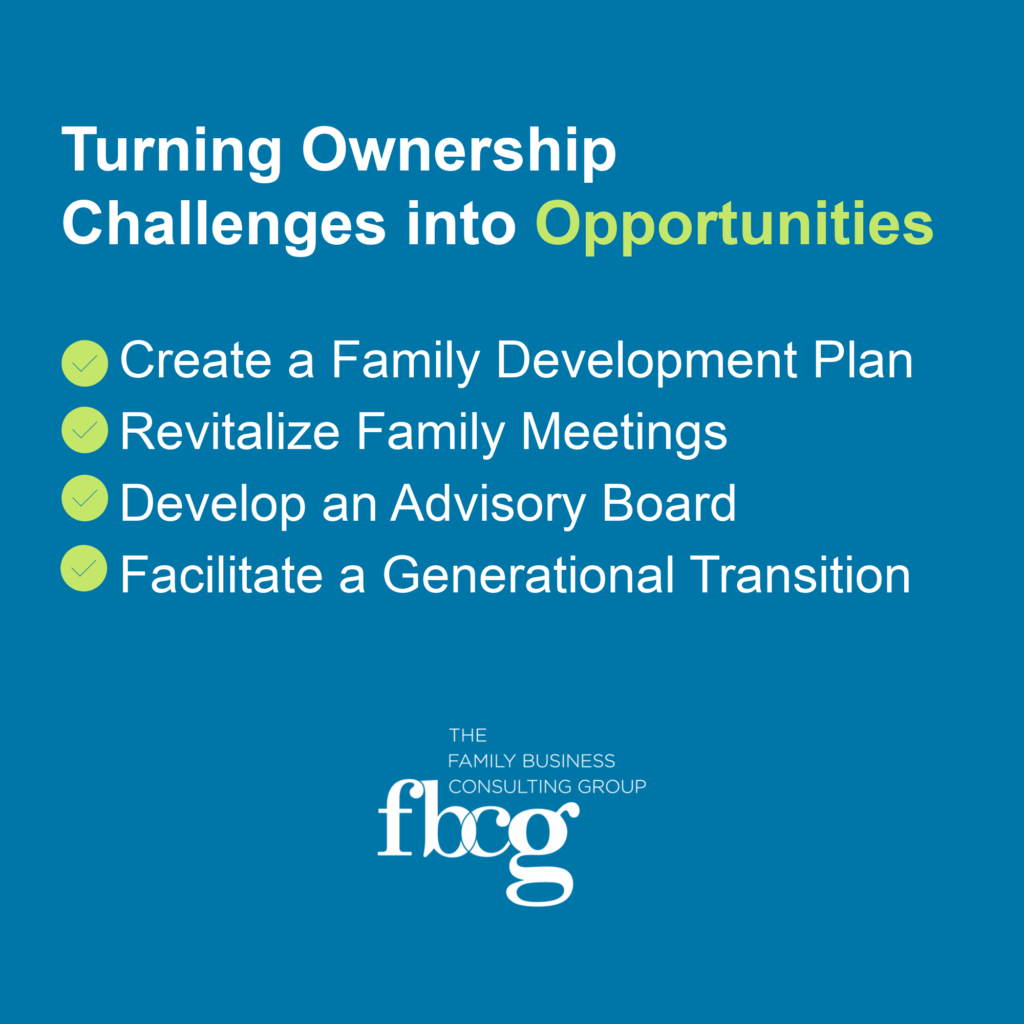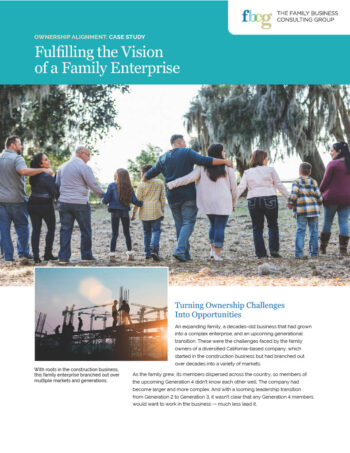Download Case Study»
An expanding family, a decades-old business that had grown into a complex enterprise, and an upcoming generational transition. These were the challenges faced by the family owners of a diversified California-based company, which started in the construction business but had branched out over decades into a variety of markets.
As the family grew, its members dispersed across the country, so members of the upcoming Generation 4 didn’t know each other well. The company had become larger and more complex. And with a looming leadership transition from Generation 2 to Generation 3, it wasn’t clear that any Generation 4 members would want to work in the business — much less lead it.
Rather than waiting for a crisis, the family was proactive in identifying that they needed help with ownership alignment. “We wanted to find ways to develop the rising generation as responsible owners,” said the chair of the family council. Based on their knowledge of family business best practices, they thought writing a family constitution might help.
Choosing to Work with FBCG
A member of the family council heard about The Family Business Consulting Group (FBCG) and Senior Consultant Joshua Nacht, Ph.D., from a peer in another family business. They thought Josh would bring fresh ideas and connect well with the members of Generation 4. After meeting him, they determined that there was a good cultural fit: he listened well to their needs, spoke their language and understood their West Coast culture and demeanor.
They liked the fact that they were able to establish a trusting relationship with Josh while also having access, through him, to a larger network of FBCG’s family business experts. “You’re not just working with one consultant — they have a network of consultants he can tap into and an archive of FBCG resources to draw upon,” the family council chair said.

Co-Creating Solutions: A Collaborative Process
Josh started by working with the family council to flesh out the family’s vision, values, and plans – and to determine how to achieve their goals. It soon became clear that the family’s idea of writing a constitution was not necessarily the best path. The family council chair said Josh “read the room well” at the first meeting with the council: “We weren’t really very excited about working on a constitution.”
“What they needed was more of a family development plan,” Josh said. “This would help them develop as an ownership group to steward the business for the long term.” He assured the family that this type of course correction is common, and evolving ideas is healthy. It’s one thing to realize that aspects of the family governance structure need shoring up — but another thing to actually bring ideas into action.
Josh then attended the family retreat, where he met separately with members of each generation to get a sense of their priorities. In his initial engagement with the family, Josh led the creation of the family development plan, helped the family council be more effective in their initiatives, and supported the family in revitalizing their meetings. “Josh always said his goal was to empower us to lead our own family,” said the family council chair. “His goal was pretty much to work himself out of a job.”
Once the family council became more productive and efficient, Josh’s role moved to checking in periodically with the family to make sure their efforts were sustainable for the long-term. Pleased with the process and outcome of their family governance work, the family brought Josh back to help locate and place two independent members onto their first advisory board. Even during the challenges of Covid, Josh worked with a small taskforce to identify independent members who could share their business experience and be a good cultural fit in the boardroom. This effort was successful and the two new advisory board members are making meaningful contributions to business performance evaluation and strategy development.
Focus on Outcomes
Josh and the family collaborated to move the family and the company ahead in four key areas:
1. Creating a Family Development Plan
Using a bottom-up rather than a top-down approach, the family created several committees to work on parts of their family development plan. A social committee looked at ways to build relationships among family members. A revitalized family council focused on governance. An education committee considered what family members need to know to be responsible owners. Other groups focused on philanthropy, entrepreneurship and communication.
The results have been uneven — a function of the participatory process, and the reality that the family finds it challenging to sustain work in so many areas at once. “It’s not neat and tidy, like saying, ‘We will write a constitution and then dictate it to everybody,’” the family council chair said. “But it does resonate more — people feel like they’re heard.”
The family has made quite a bit of progress: The communications committee uses a platform called Trusted Family to make it easier for members to work together. The family continues its philanthropic work, doing volunteer projects when they get together. And they created an entrepreneurial policy: If a family member wants to start a business, they can cash out their company stock, and the company will make professional advice available to them.
Not all the committees have remained active, but they may start back up again in the future. If the need arises. A key lesson the family learned: “Just try things,” said the family council chair.
2. Revitalizing Meetings
The family had been holding regular assemblies, but they resembled shareholder meetings, with lots of reports on the company’s finances that not everyone found interesting. “It turned a lot of people off,” said the family council chair. “Josh recognized that a top-down approach wasn’t really engaging our family. We needed to figure out a more grassroots approach.”
Josh worked with the family council to revamp their family assemblies. “He was very helpful in helping us understand that we need to structure our assemblies so that we are engaging people and forming the glue that keeps the family together,” said the family council chair. “He helped us figure out how to structure things so we could sneak in little bits of education and then have fun.”
Instead of meeting for several hours at a time to go over detailed business reports, for example, they might do a scavenger hunt, then come back and hold a half-hour business session over glasses of wine, then go to dinner. They found they were more productive this way. “Doing less is more for us, in terms of getting people engaged,” said the family council chair.
These family gatherings helped the ownership group align, Josh said: “It brought them increased structure and direction. It helped engage more of their younger generation.”
3. Developing an Advisory Board
When the family decided to create an advisory board — consisting of family members, independent directors and executives — for the business, they re-engaged Josh to help them write the prospectus and find independent directors.
“We don’t know that we’re going to have family members in the fourth generation working in the business,” said the family council chair. “We wanted to start setting up pathways for the family to stay involved without working in the business.” In addition to the family seats on the board, they created roles for family observers to help younger family members participate.
Finding the independent directors took longer than expected largely because of pandemic-related delays. “They were really patient and ended up getting two people who I think are a great fit, and are helping them develop what the board does, and how the board interacts with the business,” Josh said.
4. Facilitating a Generational Transition
The family was not facing intractable disagreements or big conflicts. But it’s easy to put off potentially difficult conversations — or even to not realize they are needed. Working with Josh helped the family have “some hard conversations that we needed to have,” concerning generational transitions, the family council chair said.
Josh helped the family start discussions about the leadership transition from Generation 2 to Generation 3. In addition to moderating those discussions, he helped them confront another topic where members of different generations held differing views: risk tolerance.
He also advised them on how to connect with Generation 4. “One of the things that Josh impressed on us was that if we wanted to engage our rising generation, we had to listen to them and find out what they wanted,” said the family council chair. “They’re interested in impact, in giving back and in getting to know each other. They want to be responsible owners.”
Looking Forward
The structures and processes that Josh helped the family put in place have aligned the family ownership group for future generations. By identifying areas that needed work before they caused problems, the family ensured a smooth leadership transition from Generation 2 to Generation 3 — and laid the foundation for Generation 4 to take over as owners someday. “You don’t want to have it turn into a crisis,” said the family council chair. “Good family governance is all about creating avenues to have discussions and to be proactive before anything turns into an issue.”
The family is aware that their work is not done. “It’s not like they do education once and they’re done with it,” Josh said. “There are new topics to cover and new family members to educate.” He stays in touch with the family several times a year to see how their work together is progressing and to maintain a connection.
Josh acknowledges that this is a family that is highly capable and motivated to sustain their family and business legacy. They just needed a guide to help them become more organized and structured about the work they were doing. They didn’t need someone to prescribe solutions, but rather to help them have effective conversations and to move forward in a more intentional manner. Josh proudly said, “This is a true champion family — one who has accomplished a lot through their engagement. They recognize the need to continue working to sustain their success and pass along a thriving family enterprise to the next generation. It was an honor to be part of their journey.”
